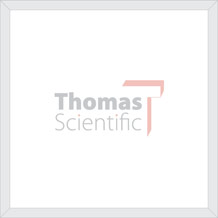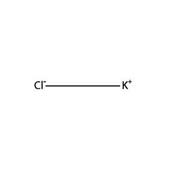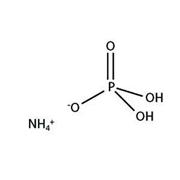bioWORLD, Chemicals, 500 g
-
L-Asparagine
bioWORLDSynonym: ( S )-2-Aminosuccinic acid 4-amide, L-Aspartic acid 4-amide Anhydrous Appearance: White Crystalline Powder Density : 1.543 g/cm3 HS Code : 29241900 IUPAC_Name: Asparagine Melting Point: 235°C
-
Tryptic Soy Agar
bioWORLDUsed for the isolation and cultivation of nonfastidious and fastidious microorganisms Can be prepared with or without blood or enrichments pH: 7.3 Working Concentration: 40 g/L Dehydrated Appearance: light beige, homogeneous powder Prepared Appearance: Plain – light…
-
For the isolation and cultivation of lactic streptococci Does not contain β-glycerophosphate or lactose pH: 7.0 Dehydrated Appearance: beige to medium tan, homogeneous powder Prepared Appearance: medium amber broth Contains (per liter): Tryptone: 2.5g …
-
Agar, Phytoagar
bioWORLDFree of extra salts that are often present in many agar preparations and affect plant growth. Gel Strength: 950 g/cm 2 Working Concentration: 5−7 g/L Gelling Temperature: 38°C Moisture: 10.92% Ash Content: 1.2% Swelling Index: 9.0 mL Water Absorption:…
-
Potassium hydroxide
bioWORLDBuffer reagent Used for making potassium soap, shampoo, potassium permanganate etc. Used in dye, drugs manufacture, galvanization, carving, lithography etc. A basic reagent used for alkaline lysis and pH purposes. Specifications Reagent Grade Moisture: 10-15% …
-
Gellan Gum Powder
bioWORLDSynonym: Culturegel™ Type I: Biotech Grade Plant tissue culture tested Working Concentration: 1.5-2.5 g/L Gel Strength: 800 g/cm 2 Partially soluble in water
-
Standard Methods Agar, 500 g
bioWORLDUsed for obtaining microbial plate counts from milk and dairy products, foods, water and other materials of sanitary importance Made according to the American Public Health Association (APHA) formulation pH: 7.0 Working Concentration: 23.5 g/L Dehydrated Appearance: light beige,…
-
Beef Extract (Powder), 500 g
bioWORLDRecommended for use as a nutrient at 0.3-0.5% concentration in various culture media Can be used in fermentation studies as it is free of fermentable substrate pH: 7.0 Dehydrated Appearance: cream to tan, homogeneous powder Prepared Appearance: yellow to tan Soluble in water
-
Wilkins Chalgren Agar, 500 g
bioWORLDUsed to determin minimal inhibitory concentration (MIC’s) of antibiotics for anaerobic bacteria by the agar dilution procedure pH: 7.1 Working Concentration: 48 g/L pDehydrated Appearance: light beige, homogeneous powder Prepared Appearance: yellow-beige agar Soluble…
-
R2B Broth
bioWORLDLow nutrient medium for plate detection of heterotropic bacteria in water Low concentrations of carbon and energy sources enhance the recovery of stressed bacteria Ideal for membrane filtration methods pH: 7.2 Working Concentration: 3.6 g/L Dehydrated Appearance: light…
-
MOPS, Free Acid
bioWORLDAlso known as 3-[N-Morpholino] Propane Sulfonic Acid. A zwitterionic electrophoresis buffer for RNA in agarose gels. It is not absorbed through cell membranes and it is essentially transparent to UV light. Used for culturing cells in-vitro and other biological applications. pH Range: 6.8-8 …
-
EDTA, ferric sodium salt
bioWORLDAn eliminator of enzyme catalyzed reaction inhibition. Plant culture tested. Supports or facilitates plant growth and/or shoot proliferation in two or more plant tissue cultures. Appearance: Yellow to Brown Crystalline Powder Boiling Point: 614.2°C Density: 7.87 g/cm3 at…
-
Used in the selective isolation and cultivation of Clostridium difficile To be prepared with the addition of blood, cycloserine, and cefoxitin pH: 7.4 Dehydrated Appearance: light beige, homogeneous powder Prepared Appearance: light to medium amber broth Soluble in…
-
Ammonium Acetate
bioWORLDBeing the salt of a weak acid and a weak base, ammonium acetate has a number of distinctive properties. It is occasionally employed as a biodegradable de-icing agent. It is often used with acetic acid to create a buffer solution, one that can be thermally decomposed to non-ionic products. It is…
-
Potassium Carbonate, anhydrous
bioWORLDSynonyms: Carbonate of potash; Dipotassium carbonate; Dipotassium salt; Pearl ash; Potash; Salt of tartar; Salt of wormwood A potassium salt for deproteinization and as a drying agent Common biochemical reagent used in soap, glass, and china production and as a drying agent and…
-
Boric acid (Molecular Biology Grade)
bioWORLDA commonly used molecular biology reagent and also used in electrophoresis buffers. pKa (@ 20°C): 9.24 Molecular Biology Grade (also available in Proteomics Grade) Chloride: <.001% Phosphate: <0.001% Sulfate: <0.01% Calcium: <0.005% Heavy metals…
-
bioPLUS™ Sodium Chloride
bioWORLDSodium Chloride is arguably the most essential salt in molecular biology and cell culture. It is a common ingredient in cell culture media, lysis buffers, and protein storage. Molecular Biology Grade Sodium Chloride is of >99% purity and has been thoroughly tested for chemical impurities. It is…
-
Potassium Chloride
bioWORLDA common laboratory reagent and standard Specifications ACS Grade Iodide: <0.002% Bromide: <0.01% Chlorate and Nitrate: <0.003% Nitrogen compounds: <0.001% Phosphate: <0.0005% Sulfate: <0.001% Barium: <0.001% …
-
Potassium iodide
bioWORLDA simple iodide salt utilized as a fluorescence quenching agent An inorganic compound used medicinally in tablets. A precursor to silver iodide in photography. A component in some disinfectants and hair treatment chemicals. Used as a nutritional supplement in animal feeds and…
-
Pancreatic Digest of Casein, 500 g
bioWORLDGeneral purpose growth peptone used for the cultivation of most bacteria and fungi and some protozoa Can be used for indole testing because of its high tryptophan content Is biologically free of carbohydrates and is recommended for fermentation studies Can be used to determine…
-
Sodium Alginate
bioWORLDSodium Alginate, or Alginic Acid Sodium Salt, is a natural amylose carbohydrate distilled from algae. It is used in biotechnology as an effective stabilizer and emulsifier. In the presence of Calcium ions, Sodium Alginate has been observed to form cross-linked gels for cell immobilization. Plant…
-
A-1 Medium, 500 g
bioWORLDUsed in the detection of coliform microorganisms in water and food products. pH: 6.9 Dehydrated Appearance: light beige, lumpy powder Prepared Appearance: Light amber Soluble in boiling water Composition (g/L): Sodium Chloride:5g Lactose: 5g Salicin: 0.1g …
-
Ammonium chloride
bioWORLDA compound used in the lysis of red blood cells and protein isolation techniques. It is a reagent used in a variety of industrial and research applications. Useful in protein isolation techniques. Also used in the study of basic calcium phosphate crystals in fibroblasts. Inhibits intracellular…
-
EDTA, disodium salt, dihydrate
bioWORLDA metal chelating agent commonly used in tissue culture media and biological buffers. Inactivates nucleases. Also known as Ethylenediaminetetraacetate, disodium salt, dihydrate Biotechnology Grade (also available in Pretoemics Grade) Insolubles: <0.005% Heavy metals (as Pb):…
-
Ammonium phosphate, dibasic
bioWORLDIt is used as Fertilizer, fire retardant, yeast nutrient in winemaking and brewing mead. DAP is also used as a yeast nutrient in winemaking and brewing mead; It is also used as an additive in some brands of cigarettes purportedly as a nicotine enhancer; to prevent afterglow in matches, in purifying…
-
bioPLUS™ Tris Hydrochloride
bioWORLDTris Hydrochloride is a zwitterionic buffer used extensively in genomics and proteomics applications, such as chromatography. Tris HCl can be used in most applications where Tris-Base is normally used, keeping in mind that pH of the solution will be acidic without adjustment. It can be an effective…
-
Luria-Bertani (LB) Agar, Miller
bioWORLDFor propagation and maintenance of Escherichia coli Contains twenty times the sodium chloride level of Luria Agar Base, Miller and twice the level found in LB Agar, Lennox pH: 7.0 Working Concentration: 40 g/L Dehydrated Appearance: light tan, homogeneous powder Prepared Appearance: light…
-
Ferric chloride, hexahydrate
bioWORLDA catalyst in organic synthesis ACS grade Insolubles: <0.01% Nitrate: <0.01% Phosphorus (as PO4: <0.01% Sulfate: <0.01% Copper: <0.003% Ferrous Iron: <0.002% Non-precipitables (NH4OH):<0.1% Zinc: <0.003 Regulated…
-
Brain-Heart Infusion Agar
bioWORLDUsed in the cultivation of a wide variety of microorganisms including bacteria, yeasts and molds With the addition of 5% or 10% sheep blood, it is used for the isolation and cultivation of a wide variety of fungal species from clinical and nonclinical sources pH: 7.4 Dehydrated…
-
Used for cultivating microorganisms from highly viscous or gelatinous materials pH: 7.2 Working Concentration: 25 g/L Dissolve in 960 mL purified water with 40 mL polysorbate 20 Dehydrated Appearance: beige, homogeneous powder Prepared Appearance: light amber broth …
-
EGTA (Ethyleneglycol bis (2-Aminoeth
bioWORLDA metal chelating agent specific for calcium ions. Commonly used in tissue culture media and biological buffers. Also known as Ethyleneglycol bis (2-Aminoethyl ether)-N,N,N',N' tetraacetic acide Ultra Pure Grade DNAse (exonuclease), NICKase (endonuclease), RNAse, and…
-
Ammonium phosphate, monobasic
bioWORLDIt is formed when a solution of phosphoric acid is added to ammonia until the solution is distinctly acidic. It is often used in the blending of dry agricultural fertilizers. It supplies soil with the elements nitrogen and phosphorus in a form which is usable by plants. The compound is also a…

































